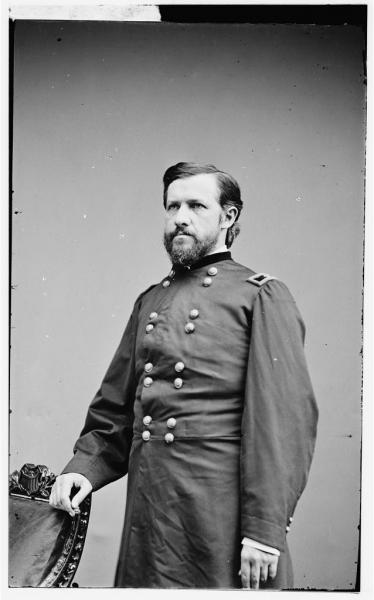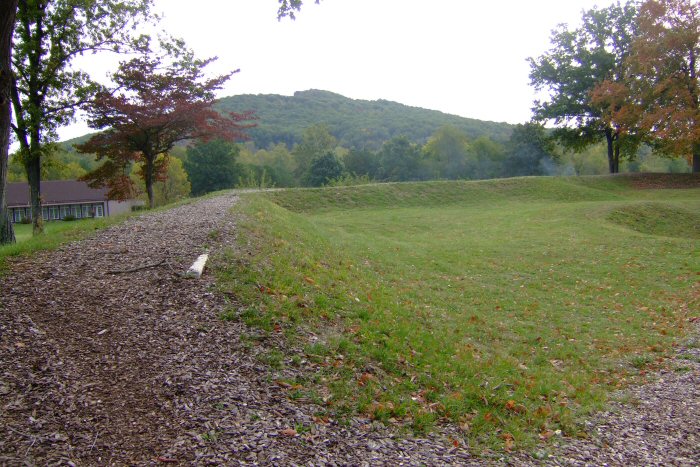By Deborah Keating, University of Missouri-Kansas City
Biographical Information:
- Date of birth: August 7, 1829
- Place of birth: Lancaster, Ohio
- Claim to fame: Private secretary to President Zachary Taylor, 1849-1850; Chief Justice of Kansas, 1861-1862; Colonel of the 11th Kansas Cavalry, 1862-1863; Brigadier General and Commander of the District of the Border, 1863-January 1864; Ohio Congressman, 1877-1881; issued General Order No. 11 during the Civil War
- Political affiliations: Republican Party, Democratic Party
- Date of death: January 21, 1896
- Place of death: New York City
- Cause of death: Hit by a car
- Final resting place: Oakland Cemetery, New York City
Thomas Ewing Jr. is perhaps most remembered for issuing and enforcing General Order No. 11 during the Civil War. But Ewing’s legacy far exceeds this one event. Ewing was a vital player in engineering the entry of Kansas into the Union as a free state, served as the first Justice of the Kansas Supreme Court, defended Dr. Samuel Mudd against conspiracy charges in the Lincoln assassination, and was a member of Congress from Ohio as well as a self-trained military leader during the Civil War.
Ewing was born on August 7, 1829, in Lancaster, Ohio into a highly influential, political family. His father, Thomas Ewing Sr., was Secretary of the Treasury under President William Henry Harrison, Secretary of the Interior under President Zachary Taylor and a U.S. Senator from Ohio (1850-1851).
Along with his brothers, cousins, and his foster-brother, William Tecumseh Sherman, Ewing was educated at the private Lancaster Academy which was founded by the Ewing and Sherman families. From 1849–1850, Ewing served as private secretary to President Zachary Taylor and after Taylor’s death, enrolled but did not receive degrees from Brown University and the Cincinnati Law School. While waiting for the right opportunities to enter politics he traveled and met Ellen Cox whom he married on January 8, 1856.
An exciting and non-traditional opportunity to enter national politics presented itself when Kansas became a territory and statehood seemed on the horizon.
An exciting and non-traditional opportunity to enter national politics presented itself when Kansas became a territory and statehood seemed on the horizon. He hoped to establish himself in Kansas and thereby gain appointment to represent Kansas in the U.S. Senate. With this goal in mind, he and Ellen moved to Leavenworth, Kansas, in 1856, where he worked to earn his fortune as a lawyer and land speculator while developing his political base.
Ewing was antislavery in his beliefs and gravitated toward the Free-State Party. In 1858 he was a delegate to the Leavenworth Convention and was instrumental in having the Wyandotte (free state) Constitution adopted as the one under which Kansas entered the Union. He was not appointed senator, but he was chosen to be the first chief justice of the Kansas Supreme Court and was sworn in on February 9, 1861.
When the Civil War broke out, Ewing helped organize the 11th Kansas Infantry. When he was appointed colonel over the unit, he resigned as chief justice. In September 1862, the 11th Infantry became part of the District of Missouri. In June 1863, Ewing was made commander of the District of the Border, which included those parts of Kansas and Missouri north of the 38th parallel.
The guerrilla warfare that dominated the border region reached its apex with Quantrill’s raid on Lawrence, Kansas, in August 1863. Determined to eliminate the incessant cross-border raids, Ewing issued General Order No. 11 requiring all persons living in Bates, Cass, Jackson, and upper Vernon Counties in Missouri to leave the area by September 9, 1863. The evacuation order forced 20,000 Missourians out of their homes. George Caleb Bingham, a famous Missouri painter and state politician, immortalized the evacuation in two identical paintings titled Martial Law or Order No. 11.
While General Order No. 11 remains controversial, contemporary Union supporters believed that it was necessary to bring some measure of peace to the District. Nonetheless, Ewing’s political support was weakened both among the army’s leaders and in Washington.
Ewing and his men escaped under cover of darkness by moving silently along a road that ran between two Confederate encampments.
In November 1864, the Department of Kansas was enlarged to include Kansas, Nebraska Territory, Colorado Territory, Indian Territory, and Fort Smith, Arkansas. The Department was placed under Major General Samuel Curtis, a supporter of James Lane, U.S. Senator (1861-1866). In the process, Thomas Ewing temporarily lost his command, but in March 1864 he was reassigned to the District of St. Louis under General William Rosecrans, where he continued to fight Missouri pro-Confederate guerrillas. His stern methods sustained his reputation as being ruthless and unrelenting in his determination to root out the disruptive rebel forces.
In addition to his activities against Missouri’s guerrillas, Ewing also contended with the Confederate Army, which invaded Missouri in the fall of 1864. On September 27, 1864, General Ewing led a small contingent of Union soldiers against General Price’s significantly larger Confederate force at Pilot Knob. Despite being outnumbered, Ewing initially refused to surrender the fort where his Union forces had taken cover. The ensuing battle left 1,000 Confederate soldiers dead. Recognizing his precarious situation, Ewing and his men escaped under cover of darkness by moving silently along a road that ran between two Confederate encampments. After Ewing’s departure, a slow-burning fuse lit by the Union soldiers blew up the magazine, thus preventing it from falling into Confederate hands.
Ewing resigned his commission in February 1865. Initially, he planned to remain in Kansas, where Order No. 11 was popular, but he underestimated the determination of strong political enemies, such as James H. Lane and George Caleb Bingham, who lobbied against him. Ewing compounded the damage to his political career when, in May 1865, he successfully defended Elman “Edward” Spangler, Samuel Arnold and Dr. Samuel A. Mudd, all of whom were accused of conspiracy in Lincoln’s assassination. Recognizing that he would not be able to obtain an appointment to political office, he moved to Washington, D.C. to practice law.
In 1870, Ewing returned to his native state of Ohio and was elected to serve in the United States Congress between 1877 and 1881. He never attained his dream of becoming a United States Senator and after leaving Congress never stood for election again. He moved to New York City and again opened a law practice. Thomas Ewing Jr. died at the age of 66 on January 21, 1896, after being struck by a street car in New York City.
Suggested Reading:
Brownlee, Richard S. "The Battle of Pilot Knob, Iron County Missouri, September 27, 1864." Missouri Historical Review. No. 59, Issue 1 (October, 1964): 1-30.
Library of Congress, Manuscript Division. Thomas Ewing Family Papers. Washington, D.C.
Monks, William. A History of Southern Missouri and Northern Arkansas; being an Account of the Early Settlements, the Civil War, the Ku-Klux and Times of Peace. John F. Bradbury Jr. and Lou Wehmer, eds. Fayetteville: University of Arkansas Press, 2003.
Smith, Ronald D. Thomas Ewing, Jr.: Frontier Lawyer and Civil War General. Columbia: University of Missouri Press, 1947.
Cite This Page:
Keating, Deborah. "Ewing, Thomas, Jr. " Civil War on the Western Border: The Missouri-Kansas Conflict, 1854-1865. The Kansas City Public Library. Accessed Tuesday, April 16, 2024 - 04:39 at https://civilwaronthewesternborder.org/encyclopedia/ewing-thomas-jr



